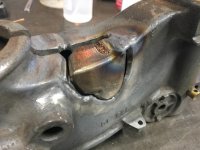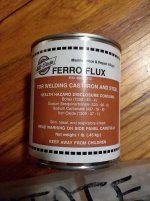steamandsteel
Aluminum
- Joined
- Oct 21, 2017
- Location
- Wichita, KS
Hello,
I'm having a hell of a time trying to braze up this casting.
It's a hollow piece, about fifteen pounds, with a wall thickness around 3/8".
I am proficient in brazing with a torch, and welding with TIG, so I figured I would give TIG Brazing a try. Did my research, kind of figured out how I should run the beads.
Here's the setup:
- A chunk broke out of the casting, triangular in shape. I ground down all the edges on the piece, and on the base casting, and beveled them with a small land and slight gap.
- Preheated to around 300 degrees with a propane torch.
- Machine set to 75 amps, but only using a quarter pedal or so. I'd guess 30-50 amps actually being used.
- Using 1/8" TIG Brazing Rod, ERCuSi, with an 1/8" Thoriated (Red) Tungsten
So, I start brazing up the cracks, and the beads flow alright. Making sure not to melt the cast iron. Keeping the arc over the bronze puddle, and dabbing every so often.
However, once I finish any bead and move to the next, the casting itself forms another hairline or sometimes more than hairline crack. Trying to fix these other cracks has led to the piece looking like a spider's web. No good at all. I've tried additional pre-heat, and even a post heat after brazing.
What the heck am I doing wrong? Should I just break out the O/A torch tomorrow?
I'm having a hell of a time trying to braze up this casting.
It's a hollow piece, about fifteen pounds, with a wall thickness around 3/8".
I am proficient in brazing with a torch, and welding with TIG, so I figured I would give TIG Brazing a try. Did my research, kind of figured out how I should run the beads.
Here's the setup:
- A chunk broke out of the casting, triangular in shape. I ground down all the edges on the piece, and on the base casting, and beveled them with a small land and slight gap.
- Preheated to around 300 degrees with a propane torch.
- Machine set to 75 amps, but only using a quarter pedal or so. I'd guess 30-50 amps actually being used.
- Using 1/8" TIG Brazing Rod, ERCuSi, with an 1/8" Thoriated (Red) Tungsten
So, I start brazing up the cracks, and the beads flow alright. Making sure not to melt the cast iron. Keeping the arc over the bronze puddle, and dabbing every so often.
However, once I finish any bead and move to the next, the casting itself forms another hairline or sometimes more than hairline crack. Trying to fix these other cracks has led to the piece looking like a spider's web. No good at all. I've tried additional pre-heat, and even a post heat after brazing.
What the heck am I doing wrong? Should I just break out the O/A torch tomorrow?






